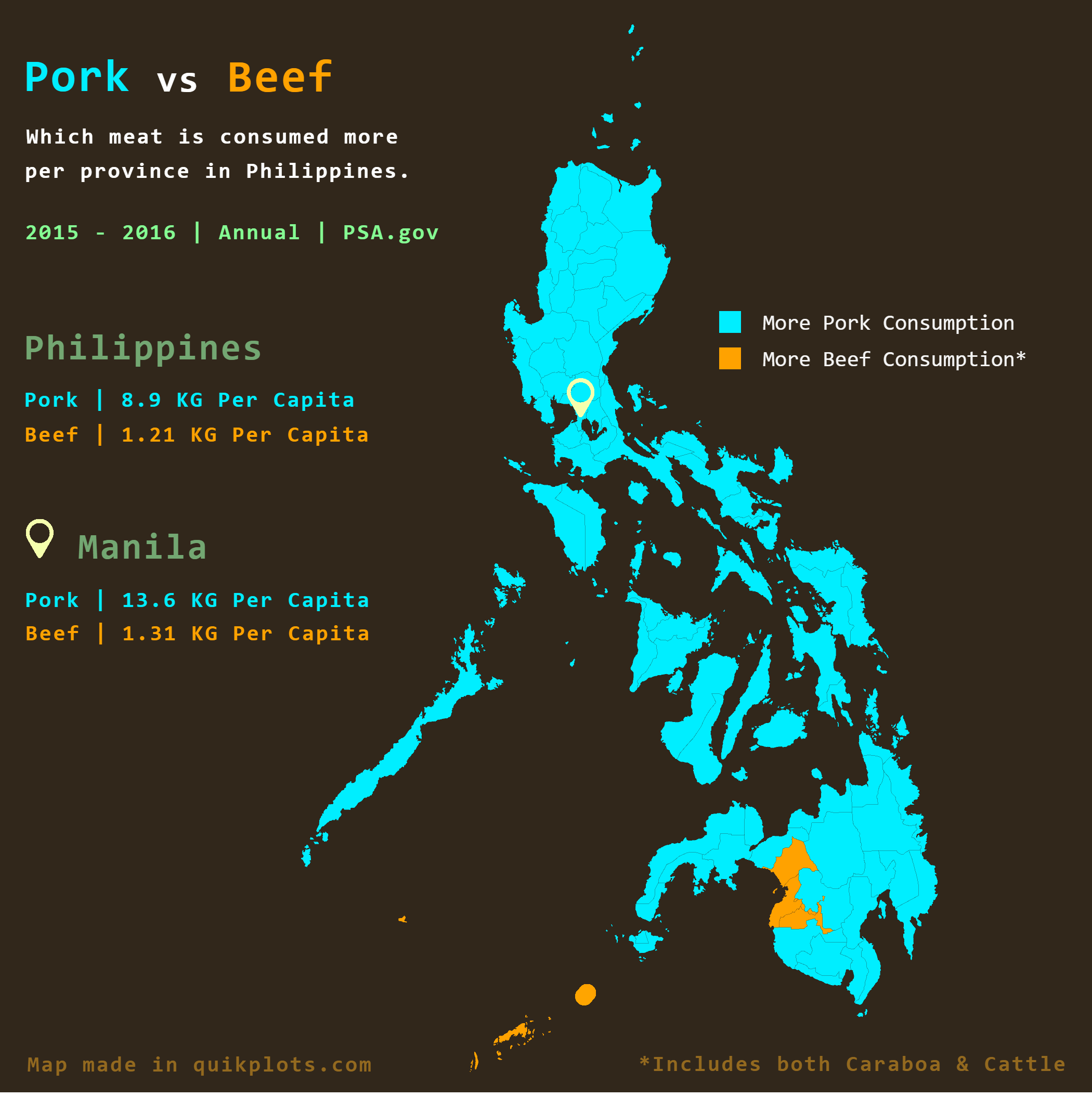Pork Vs Beef Consumption in the Philippines Map


Alex Cartwright
Senior Cartographer & GIS Specialist
Alex Cartwright is a renowned cartographer and geographic information systems specialist with over 15 years of experience in spatial analysis and data...
Geographic Analysis
What This Map Shows\nThis geographical visualization presents a stark comparison between pork and beef consumption across the various provinces of the Philippines. The map highlights areas where pork is favored over beef and vice versa, providing a clear visual representation of dietary preferences in the country. By delving into these consumption patterns, we can gain insight into cultural influences, agricultural practices, and regional economic factors that shape dietary habits in the Philippines.
Deep Dive into Pork and Beef Consumption in the Philippines\nThe Philippines has a rich culinary heritage influenced by various cultures, and meat consumption plays a significant role in Filipino diets. Pork is the most popular meat in the country, often used in traditional dishes such as lechon, adobo, and sinigang. Interestingly, the annual per capita pork consumption in the Philippines is high, with Ilocos Norte leading the way at 17.74 kg. This figure illustrates not only a preference for pork but also reflects the province's agricultural practices, which are tailored toward swine production.
On the other hand, beef consumption is more prevalent in certain regions, particularly in the Bangsamoro Autonomous Region in Muslim Mindanao (BARMM). Provinces like Lanao Del Sur, Maguindanao, Sulu, and Tawi-Tawi have a higher beef consumption rate compared to pork. This trend can be attributed to cultural and religious practices, as beef is often preferred in Muslim communities where pork is not consumed due to dietary laws. In these areas, cattle farming may be more common, leading to a higher supply of beef and thus greater consumption.
The differences in meat consumption can also be linked to economic factors. Regions that produce more of a specific type of meat often see increased consumption of that meat. For example, provinces with significant agricultural production of pork are likely to have better access to this meat, making it a staple in local diets. Conversely, areas that focus on cattle ranching will naturally consume more beef. The interplay of these economic and cultural elements creates a fascinating landscape of dietary preferences throughout the Philippines.
Regional Analysis\nWhen we analyze the map, several distinct patterns emerge. In the northern regions, particularly in Luzon, pork consumption dominates. Provinces such as Ilocos Norte and Pampanga are known for their pork delicacies, which are integral to local cuisine and festivals. Pampanga, in particular, is often referred to as the culinary capital of the Philippines, with dishes that celebrate pork in various forms.
In contrast, the Mindanao region presents a different picture. Provinces like Lanao Del Sur and Sulu highlight the significance of beef consumption, aligning with the predominant Muslim population in these areas. The dietary habits in these provinces reflect not only cultural preferences but also the agricultural practices that support beef production.
Interestingly, the map also reveals a transition zone in some central areas of the Philippines, where pork and beef consumption is more balanced. This could signify a blending of culinary traditions, as urbanization and migration introduce diverse dietary habits. As people move and settle in these areas, their culinary preferences can meld, leading to a more varied diet that includes both meats.
Significance and Impact\nUnderstanding the dynamics of pork versus beef consumption in the Philippines is crucial for several reasons. Firstly, it sheds light on the agricultural landscape and food security within different regions. Knowing which meat is more popular can guide farmers and policymakers in making informed decisions about livestock production and agricultural support.
Moreover, these consumption patterns reflect broader societal trends. With the rise of globalization, we see shifts in dietary preferences influenced by international cuisine and food trends. This could lead to increased demand for beef in areas traditionally dominated by pork consumption. Additionally, as the population grows, food sustainability becomes a pressing issue. The demand for certain meats may drive changes in farming practices and environmental impacts, making it essential to monitor these trends closely.
In conclusion, the map of pork versus beef consumption in the Philippines not only highlights dietary preferences but also serves as a lens into the cultural, economic, and agricultural intricacies of the nation. As we observe these patterns, we can better understand the factors that shape Filipino cuisine and the potential implications for the future of food in the country.
Visualization Details
- Published
- October 15, 2025
- Views
- 42
Comments
Loading comments...